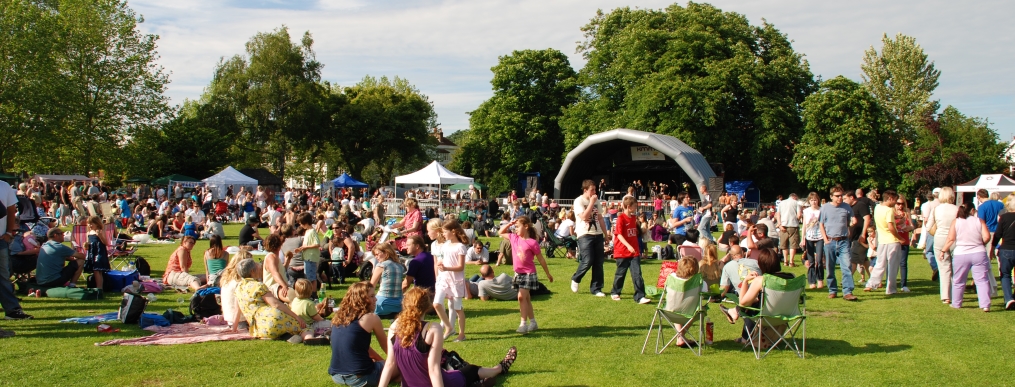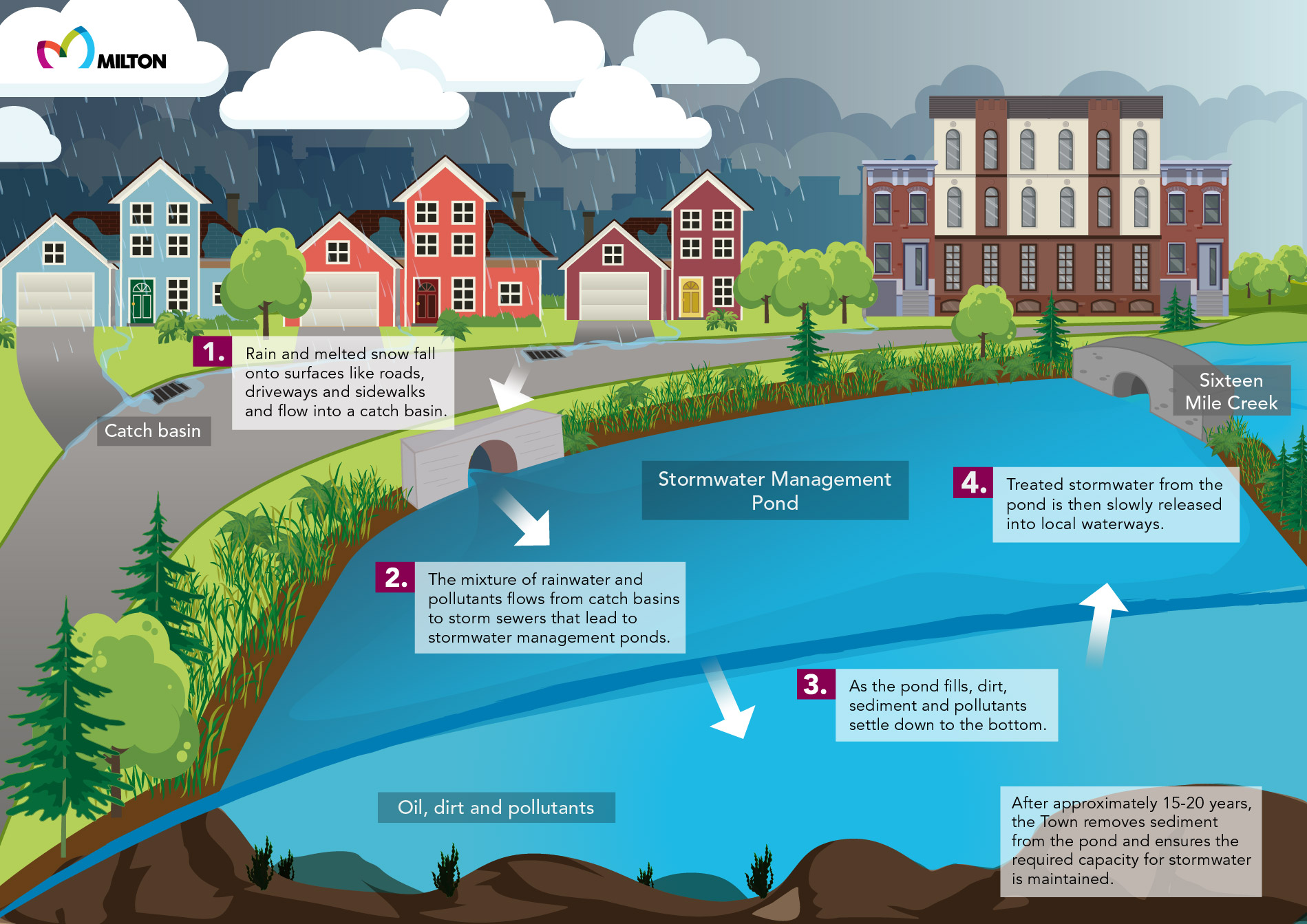
In a natural environment, rain and melted snow fall onto soft surfaces such a grass and infiltrate into the ground. In urbanized areas, rain and melted snow fall onto hard surfaces like roads, driveways and sidewalks and continue to travel without infiltrating. This can cause flooding.
As the rain and melted snow flows across these hard surfaces it collects oil, dirt and pollutants. The rainwater mixed with pollutants then flows into our storm sewers, stormwater management ponds, rivers and natural waterways. The Ministry of the Environment, Conservation and Parks (MECP) defines this mixture of rainwater and pollutants as municipal sewage.

A stormwater management pond is engineered infrastructure built to collect and treat rainfall and surface water runoff, as required by MECP legislation. The ponds are usually found in neighbourhoods, where stormwater can easily be collected and treated.
During rainfall, stormwater flows into the pond and fills the basin of the pond. As the pond fills, dirt, sediment and pollutants settle down to the bottom. When the pond fills to its capacity, the water spills out at a controlled rate to reduce flooding and erosion to local waterways. The pollutants and sediment are left behind in the pond. Aquatic plants in the pond help with treating pollutants and plants around the edges of the pond help to stabilize banks and shade the water.
Benefits
- Engineered habitat for wildlife
- Naturalized space for walking and bird watching
- Protects the natural environment from contaminants and erosion
- Provides flood protection
- Reduces flooding
Rear yard catch basins
Rear yard catch basins are located at low points along backyard property lines. They connect stormwater to our natural waterways. It is the homeowner’s responsibility to ensure that a rear yard catch basin is not blocked in any way that would prevent stormwater from entering it.
If you have a catch basin in your backyard:
- Don’t pour anything down the catch basin, only stormwater goes down catch basins
- Don’t build on, or cover, the catch basin
- If you have any questions or concerns, please contact us
Staying safe around the pond
As these ponds mature, they are also pleasant to look at and walk near. Practice safety when around a stormwater pond as water levels can change quickly during storm events.
Do:
- Keep catch basins clear of debris
- Enjoy passive recreation around the ponds (walking, bird watching)
- Report illegal dumping to the Town by calling 905-878-7252
Don't:
- Put anything, including garbage and pollutants, down catch basins or in a stormwater management ponds
- Engage in recreational activities (skating, swimming, fishing, boating, etc.) in or on the ponds
During the warmer months remember to exercise safety around stormwater management ponds as water levels can fluctuate quickly.
Community members are welcome to enjoy the scenery and passive recreational activities such as walking and bird watching.
Follow these guidelines to stay safe around the stormwater ponds:
- Don’t fish, swim or boat in stormwater management ponds
- Do enjoy the scenery around the pond by staying on designated and marked trails
- Don’t allow children and pets around the pond shoreline as the shoreline can be slippery
Areas with frozen lakes, ponds, channels and reservoirs can be beautiful places to visit during the winter months but all too often many people risk their lives by venturing onto frozen water. It’s important to be aware of the dangers and risks associated with water and ice at this time of year.
Stormwater management ponds
The Town of Milton does not monitor ice conditions on storm water management ponds. It is dangerous to walk, play or skate on any ice surface that has areas of open water. Stormwater management ponds are unsafe for skating, tobogganing, and ice hockey for a number of reasons:
- Due to the continuous flow of water in these ponds, the ice that forms in winter is unstable
- The ice depth varies across the pond’s surface
- Many ponds collect road runoff that may contain salt, which lowers the freezing temperature of the water
Please stay off stormwater management ponds at all times.
Pets
Please keep your pets on a leash when walking near ice-covered water. Pets are not aware of the hidden danger of falling through the ice. If your pet does happen to get loose on the ice, coax it back to shore - do not go after it. If your pet falls through the ice call 911 immediately. Do not attempt to rescue your pet yourself. The fire department will respond with ice rescue equipment and attempt to rescue your pet.
Outdoor skating
Throughout winter months, skating is prohibited on bodies of water such as stormwater management ponds and channels.
Other ways to protect yourself outdoors this winter
- Inform others of your destination and expected time of return
- Check weather conditions
- Dress in layers to protect against hypothermia (decreased body temperature)
If you see someone fall through the ice call 911 immediately. Do not try to go out on to the ice to help them.
More information about winter water safety can be found on the Life Saving Society website.
If you have questions or concerns regarding West Nile virus, standing water, ticks and Lyme disease, please visit Halton Region's website for more information, including contact information.
Frequently asked questions
The Town owns and operates stormwater management ponds after assumption of a subdivision. We inspect the ponds annually and conduct an in-depth inspection, including the measurement of sediment every five years. After approximately 15 to 20 years, the Town removes sediment from the pond.
To remove sediment, we need to pump water out of the pond, relocate wildlife and remove sediment with the use of heavy machinery. This process is invasive, but is also necessary to ensure that there is space available in the basin to continue collecting stormwater and sediment, in order to reduce flooding and protect local waterways.
Only stormwater is meant to go down a catch basin. As the owner of a private swimming pool, hot tub or spa, it's your responsibility to safely empty the water.
- Do not drain pool water directly into a catch basin
- Discontinue chlorination or chemical water treatments five days prior to pumping the water out
- Slowly pump water to your lawn or grassed area (do not pump to a neighbour’s property or cause water to pool on a neighbouring property)
Learn about flood hazard mapping.
Contact Us
Development Services
150 Mary Street Milton, ON Canada L9T 6Z5
Phone: 905-878-7252 ext 2398 | Toll Free: 800-418-5494 | Fax: 905-876-5024 | Email Development Services



